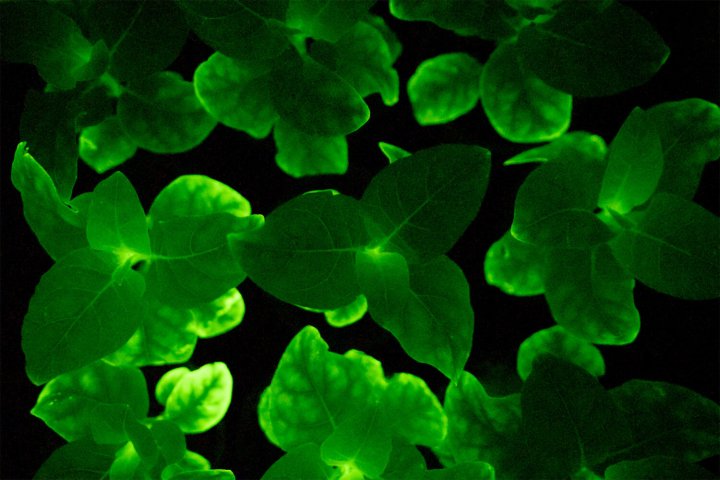
In Avatar, James Cameron’s 2009 science-fiction epic, the resource-rich world of Pandora is covered in tropical rainforests, all glowing with luscious phosphorescence like some kind of underwater paradise. According to a Wired article published at the time of the movie’s release, Cameron hired a plant sciences specialist from the University of California, Riverside. The specialist spent weeks writing detailed scientific explanations for the dozens of flora on Pandora, explaining exactly how their alien bioluminescence works. After all, no such thing exists on our planet. Right?
Hold that thought. Because a team of international researchers this month announced that they have created plants that produce a visible, glowing green luminescence. The results could potentially be used for everything from better studying the inner workings of plants to producing aesthetically interesting flower displays for rave-inspired weddings. It’s probably too early to write to your city council to suggest swapping out street lighting for glowing trees, but it’s not entirely out of the question either!
“There are many possible applications of this technology,” Keith Wood, CEO of Light Bio, the company that could one day bring this work to market, told Digital Trends. “Most notably [it could] allow scientists to observe the living processes occurring within plants, and to allow the general public to experience the internal living energy within [these same] plants. Specifically, we are referring to the possibility of house plants and flowers that glow in the dark.”
Not mushroom for glowing
The light-emitting plants were developed by inserting bioluminescent DNA from a mushroom into a tobacco plant. Tobacco plants were used because of their simple genetics and rapid growth, although other plants could be utilized in the future. Feasibility has already been shown with plants including periwinkle, petunia, and rose. Plants that contain the mushroom DNA glow continuously throughout their lifespan (not just at night), all the way from seedling through to mature plant.
The project was carried out by researchers at Moscow biotech company Planta, working with the Institute of Bioorganic Chemistry of the Russian Academy of Sciences, MRC London Institute of Medical Sciences, and the Institute of Science and Technology Austria, and others. Light Bio is the company spun out to bring these luminescent plants to market in ornamental house plants, in partnership with Planta.
“Bioluminescence is one of the most fascinating and diverse phenomena found in nature,” Wood explained. “Many scientists worldwide are working to better understand the underlying foundations for these living lights. They also recognize that these have many practical and aesthetic applications.”
The work was led by Dr. Ilia Yampolsky, who discovered the biochemical basis for bioluminescence in mushrooms. The unique insight was not just discovering the natural bioluminescence found in some mushrooms, but also that it was unexpectedly compatible with the basic metabolism common to all plants. Through collaboration, the researchers formulated their hypothesis that glowing plants may be a real feasible possibility.

This is not the first time that researchers have explored bioluminescence in plants. In 1985, Light Bio’s founder Wood was harnessing the underlying chemistry and molecular biology responsible for the firefly’s glow to create glowing plants (again, of the tobacco variety) by inserting the relevant DNA. Since then, researchers have continued to explore the concept every few years. In 2017, for instance, Massachusetts Institute of Technology researchers were able to get an otherwise ordinary watercress plant to emit a dim light for a period of 3.5 hours by embedding specialized nanoparticles into its leaves.
Through a leaf brightly
The problem with all of these attempts? That the resulting plants simply were not that bright. This is what the new work, published in a recent paper in the journal Nature Biotechnology corrects. As its authors write:
“Autoluminescent plants engineered to express a bacterial bioluminescence gene cluster in plastids have not been widely adopted because of low light output. We engineered tobacco plants with a fungal bioluminescence system that converts caffeic acid (present in all plants) into luciferin and report self-sustained luminescence that is visible to the naked eye. Our findings could underpin development of a suite of imaging tools for plants.”
According to the researchers, the plants can reportedly produce more than a billion photons per minute. That’s enough that the results should be clearly visible. And it should be entirely possible to use the same technique to make future plants glow even brighter. It might even be feasible to integrate features like changing levels of brightness as a direct response to a plant’s surroundings. Or for the colors to cycle accordingly.
Smart home lights that change their brightness or hue depending on what you’re doing are commonplace now. But a plant that does the same thing? That’s sure to start a conversation or two at your next house party. (When such things are once again possible.) Where do we place our pre-orders?


